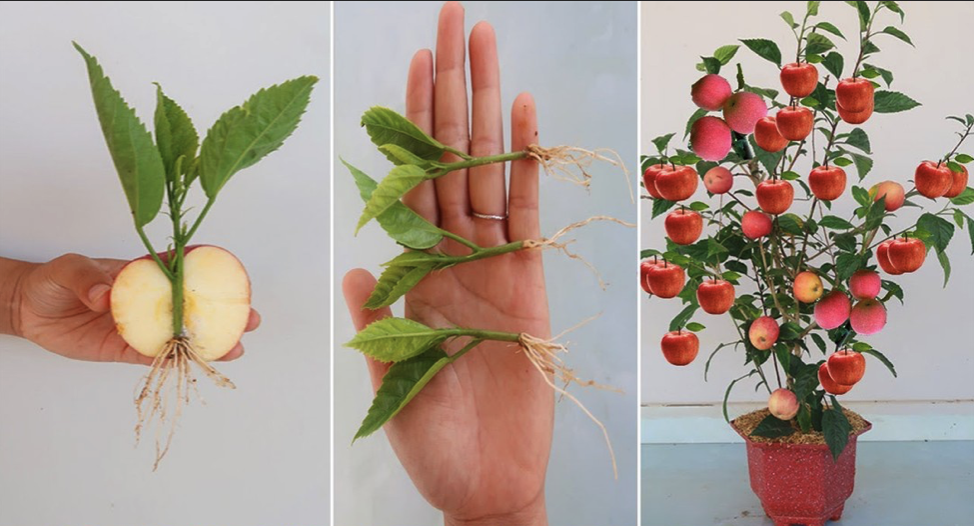Here’s How to Grow an Apple Tree from Seeds to Enjoy Year-Round

The apple is one of the most consumed fruits. Whether in pies, compotes, or clafoutis, there is no shortage of recipes to enjoy this succulent fruit. In addition to its sweet and tart flavor, the health benefits of apples should not be overlooked. We are all familiar with the popular saying that “an apple a day keeps the doctor away.” To make the most of this fruit, learn how to grow an apple tree from a few seeds for an organic harvest.
After taking a bite of your apple, don’t discard the seeds. They can serve as the seeds to grow your apple tree and enjoy the sweet fruits to the fullest. However, choose seeds from an organic apple to ensure your tree is free from any trace of pesticides. To grow your fruit tree, you need to go through several stages.
How to Grow an Apple Tree from Seeds?
Step 1: Drying the Apple Seeds
Collect the seeds from your fruit and clean them thoroughly to remove any pulp or fruit residue.

After cleaning the seeds, dry them with a cloth and place them outdoors to remove any remaining moisture.
Step 2: Germinating the Seeds
Wrap your seeds in a damp paper towel or tissue paper. Then place them in a sealed plastic bag or plastic container that you will put in the refrigerator. It’s important to provide the seeds with winter conditions as this is the period when they develop shoots and roots. You can also germinate the seeds in damp cotton or paper towels instead of using a paper towel.
The germination process takes time, so you should leave your seeds in the refrigerator for at least 8 weeks. Keep in mind that even though you have created an artificial winter for your seeds, it’s best to germinate them during the actual winter season so that you can plant them in early spring, after the frost, when the seeds come out of dormancy. After germinating your seeds, you can move on to planting.

Step 3: Planting the Seeds
To do this, choose a pot containing neutral pH soil. Dig a hole slightly larger than the size of your seed in the soil. Since the young shoot is still fragile, be careful when placing your germinated seed in the hole. The sprout should be pointing downwards.
To stimulate the growth of your apple tree, you can add compost only and avoid using fertilizer. Then cover your seed with soil, gently firm it down, and water the soil. Keep your pot at room temperature in partial shade. Apple trees appreciate warmth, but the sun could burn your small and fragile apple tree. After a few weeks, you will notice the emergence of the first leaves. Only then can you place your pot in full sunlight.

Step 4: Transplanting the Apple Tree
When your apple tree reaches a height of 10 cm, you can take it outside. You can transplant it into a large pot, but preferably plant it in the ground. Your apple tree will need space and sunlight. An apple tree requires more than 6 hours of sunlight per day. As for the soil, choose a well-draining substrate with neutral pH that retains water.
Once your tree starts to take root in the ground, water it every 10 to 12 days. You can space out the watering as the tree grows. However, if the weather is very dry, favor weekly or bi-weekly watering.
To have an apple tree and ensure fruit production, it is recommended not to rely solely on the seeds from a single variety of apples but to collect seeds from two different types to plant them together. This is because the apple tree is a self-sterile fruit tree. Thus, the pollen from one apple variety is not sufficient to fertilize the flowers of the same apple tree and produce fruit. This is also the case for other fruit trees such as cherry, plum, or pear trees.
Apple Tree Care
It is not necessary to prune your young apple tree as it will delay fruiting, especially since apple trees usually need time to bear fruit. However, you can remove any diseased or dead branches. Remember to also remove any buds to avoid having branches that will need pruning.
When your tree is large enough, give it a bit of fertilizer in spring for nourishment. Avoid using mixed fertilizers that are used for both fertilizing trees and killing weeds, as this type is not suitable for apple trees.
These instructions will help you cultivate your apple tree at home to enjoy the taste of organic apples. Just be patient as it takes time to grow.
Do you like this? Share inspiration with your friends!
Source: https://og-oasis.com
DISCLAIMER: THIS WEBSITE DOES NOT PROVIDE MEDICAL ADVICE The information, including but not limited to, text, graphics, images and other material contained on this website are for informational purposes only. The purpose of this website is to promote broad consumer understanding and knowledge of various health topics. It is not intended to be a substitute for professional medical advice, diagnosis or treatment. Always seek the advice of your physician or other qualified health care provider with any questions you may have regarding a medical condition or treatment and before undertaking a new health care regimen, and never disregard professional medical advice or delay in seeking it because of something you have read on this website.
